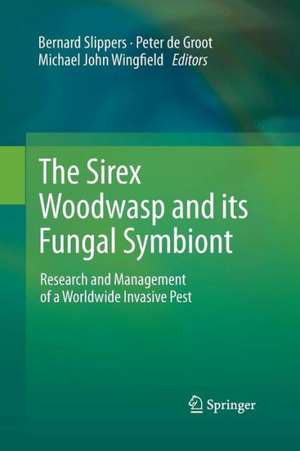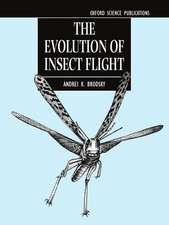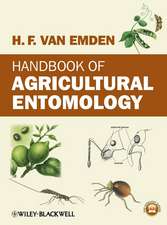The Sirex Woodwasp and its Fungal Symbiont:: Research and Management of a Worldwide Invasive Pest
Editat de Bernard Slippers, Peter de Groot, Michael John Wingfielden Limba Engleză Paperback – 11 noi 2014
| Toate formatele și edițiile | Preț | Express |
|---|---|---|
| Paperback (1) | 945.47 lei 6-8 săpt. | |
| SPRINGER NETHERLANDS – 11 noi 2014 | 945.47 lei 6-8 săpt. | |
| Hardback (1) | 949.73 lei 6-8 săpt. | |
| SPRINGER NETHERLANDS – 20 oct 2011 | 949.73 lei 6-8 săpt. |
Preț: 945.47 lei
Preț vechi: 1153.02 lei
-18% Nou
Puncte Express: 1418
Preț estimativ în valută:
180.94€ • 186.92$ • 150.59£
180.94€ • 186.92$ • 150.59£
Carte tipărită la comandă
Livrare economică 25 martie-08 aprilie
Preluare comenzi: 021 569.72.76
Specificații
ISBN-13: 9789401783415
ISBN-10: 9401783411
Pagini: 316
Ilustrații: XII, 301 p.
Dimensiuni: 155 x 235 x 17 mm
Greutate: 0.45 kg
Ediția:2012
Editura: SPRINGER NETHERLANDS
Colecția Springer
Locul publicării:Dordrecht, Netherlands
ISBN-10: 9401783411
Pagini: 316
Ilustrații: XII, 301 p.
Dimensiuni: 155 x 235 x 17 mm
Greutate: 0.45 kg
Ediția:2012
Editura: SPRINGER NETHERLANDS
Colecția Springer
Locul publicării:Dordrecht, Netherlands
Public țintă
ResearchCuprins
Preface.- Dedication.- 1. Sirex systematics; problems and solutions.- 2. Life history and biology of Sirex noctilio.- 3. Susceptibility and response of pines to Sirex noctilio.- 4. The population dynamics of Sirex noctilio F.: the influence of diapause, spatial aggregation and flight potential on woodwasp outbreaks and spread.- 5. The woodwasp Sirex noctilio and its associated fungus Amylostereum areolatum in Europe.- 6. The genetics of Amylostereum species associated with Siricids.- 7. Siricid woodwasps and their fungal symbionts in Asia, specifically those occurring in Japan.- 8. Parasitoids in the management of Sirex: Looking back and looking ahead.- 9. Factors affecting the efficacy of Deladenus siricidicola in biological control systems.- 10. Ecological considerations in using Deladenus siricidicola for the biological control of Sirex noctilio in North America.- 11. The chemical ecology of Sirex noctilio.- 12. The use of kairomone lures for the detection of Sirex noctilio in susceptible Pinus radiata plantations in Australia.- 13. The Sirex woodwasp in New Zealand: History and current status.- 14. Sirex woodwasp in Australia: current management strategies, research and emerging issues.- 15. The ecology and biological control of the woodwasp, Sirex noctilio, in Patagonia, Argentina.- 16. The woodwasp Sirex noctilio in Brazil: monitoring and control.- 17. Surveillance and control of the Sirex woodwasp: The Chilean experience.- 18. The control of the Sirex woodwasp in diverse environments: The South African experience.- 19.Sirex, surveys and management: Challenges of having Sirex noctilio in North America.- 20. Sirex research and management: Future prospects.
Textul de pe ultima copertă
The Sirex woodwasp, Sirex noctilio, is the most important invasive alien insect pest in Pinus plantations across the Southern Hemisphere, and it now threatens pines in North America. Sirex noctilio is native to Eurasia, where it causes little damage and is better known for its fascinating biology, including an obligate mutualism with the fungus Amylostereum areolatum. The wasp first appeared outside its native range around 1900 in New Zealand, and it has subsequently spread to Australia, South America and Africa. The pest continues to spread globally and this is vividly illustrated by its recent appearance in North America.
The genesis of the book was an International Sirex Symposium held in South Africa in May 2007. This symposium recognised the growing global threat from the woodwasp and the realization that a sustained research effort would be required to deal with it. This meeting succeeded remarkably in bringing together a diverse mosaic of government, industry and academic experience from many parts of the world. The shared experience emerging from the meeting, as well as the research and management work that has been undertaken subsequently, is captured in this book.
This book covers aspects of the insect’s taxonomy, life history, host-plant relationships, population dynamics and chemical ecology, as well as the nature of its obligate mutualistic relationship with the fungus Amylostereum, its distribution, diversity and biology. There is also a focus on the development and adaptation of biological control systems using various parasitic wasps and the nematode Deladenus siricidicola. Importantly, the book contains a complete synthesis of the history and current status of the pest as well as efforts to control it in the Southern Hemisphere and in North America. Overall, this book illustrates the need for a global community effort to combat the increasing threat of invasive alien pests andpathogensto the world’s forests.
The genesis of the book was an International Sirex Symposium held in South Africa in May 2007. This symposium recognised the growing global threat from the woodwasp and the realization that a sustained research effort would be required to deal with it. This meeting succeeded remarkably in bringing together a diverse mosaic of government, industry and academic experience from many parts of the world. The shared experience emerging from the meeting, as well as the research and management work that has been undertaken subsequently, is captured in this book.
This book covers aspects of the insect’s taxonomy, life history, host-plant relationships, population dynamics and chemical ecology, as well as the nature of its obligate mutualistic relationship with the fungus Amylostereum, its distribution, diversity and biology. There is also a focus on the development and adaptation of biological control systems using various parasitic wasps and the nematode Deladenus siricidicola. Importantly, the book contains a complete synthesis of the history and current status of the pest as well as efforts to control it in the Southern Hemisphere and in North America. Overall, this book illustrates the need for a global community effort to combat the increasing threat of invasive alien pests andpathogensto the world’s forests.
Caracteristici
100 Years of experience of management and research on the most serious invasive insect pest of Pinus plantations across diverse environments Richly illustrated, with a broad coverage and in depth analysis of all aspects from biological research to practical field management Insight into complex insect-fungus-tree-parasitoid-environment interactions, as well as academia-industry-government management and research interactions












